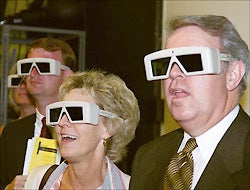ECU to use RAVE system
A group of ECU administrators might have thought they were on the control deck of the starship Enterprise recently when they took a tour of the new RAVE (Reconfigurable Advanced Visualization Environment) system installed at Joyner Library.
Never mind stars and planets whizzing by at warp speed. Instead, there were molecular particles from a single cell floating in space. And then there were the images of rooms and furniture and the sense of moving from sofa to chair, to desk, and into drawers and closets. The Queen Anne’s Revenge was on the virtual tour as well. Twenty-one cannons were strewn about on the bottom of the ocean with an anchor here and another there and planks of wood decaying on the seafloor. What! No sharks or other fishes?

“They are coming,” said Wayne Godwin of the School of Art who is working to create the shipwreck software for ECU new interactive, stereoscopic display system.
The RAVE is the product of Fakespace Systems Inc. It includes a giant 10 by 10-foot glass screen and a projection system behind it that projects stereoscopic images from a computer. The computer is a powerful Silicon Graphics Onyx2 that has enhanced graphic capability. Special goggles, wired gloves and a handheld wand pointer goes with the system. It’s a high tech array of gear that is designed for serious work. The price tag was serious too, over $325,000.
Dr. Jeffrey Huskamp, the associate vice chancellor for Information Technology and Computing Services, said the system could produce numerous visual applications involving scientific data. It can create walk-through environments and models. It’s a way of constructing things without having to actually build. Huskamp noted that the ECU system could be linked with other systems to converse and collaborate.
“It has implications for national collaboration,” he said. Among the faculty with projects for the RAVE module are Godwin who is working on the “Traveling with Blackbeard” project in collaboration with the North Carolina Department of Cultural Resources. He is designing the educational materials that focus on the excavation of the shipwreck, believed to be the Queen Anne’s Revenge, near Beaufort. Dr. Pat Lindsey of the School of Human Environmental Sciences, is involved in a National Aeronautics and Space Administration effort to design a Low Earth Orbit Hospitality Facility.
She says virtual visualization is a viable method of assessing and pre-testing the interior environments being planed for orbital living. Tom Louis and Paul Fletcher of the School of Medicine are exploring the system’s potential in medicine. Dr. Louis plans to use virtual visualization in the anatomical and pathological sciences. Dr. Fletcher says the system will show his students how molecular cells look in a three-dimensional form.
“It can contribute to learning how cells cause certain diseases like pancreatic cancer,” Fletcher said. The RAVE system is part of ECU Technology Initiative. Projects involving the system will be coordinated through CIITR (Center for Interdisciplinary Instructional Technology Research). CIITR provide campus leadership in developing technology for improved student learning. Creating an improved learning environment is the goal for the participants, so far, who have lined up for research and development time with RAVE. Godwin summed up his goals and those of his colleagues.
“Long term memory will be improved when people can conceptualize the things they hear and read about,” he said.